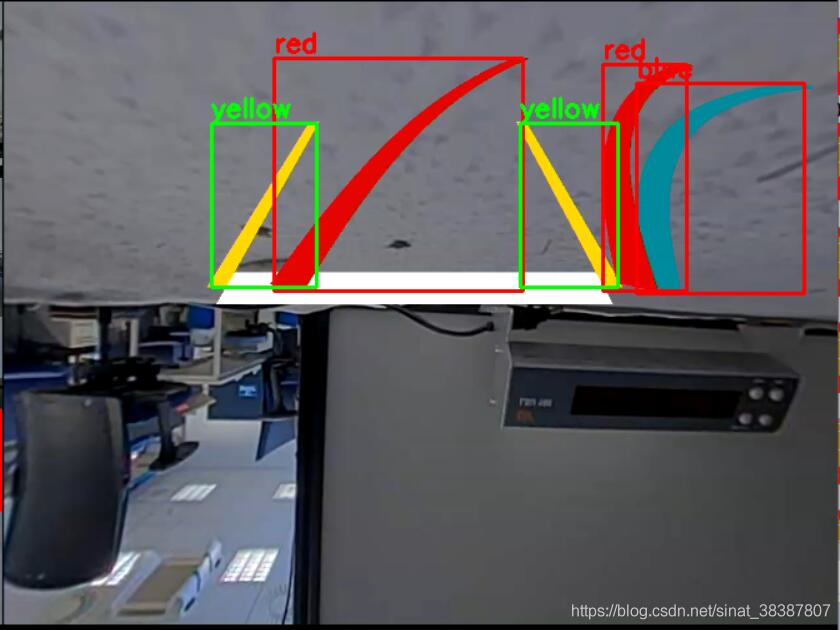本文实例为大家分享了python利用opencv实现颜色检测的具体代码,供大家参考,具体内容如下
需要实现倒车辅助标记检测的功能,倒车辅助标记颜色已经确定了,所以不需要使用深度学习的方法,那样成本太高了,直接可以使用颜色检测的方法。
1.首先需要确定待检测目标的hsv值
|
1
2
3
4
5
6
7
8
9
10
11
12
13
14
15
16
17
18
19
20
21
22
23
|
import cv2img = cv2.imread('l3.png')gray = cv2.cvtcolor(img, cv2.color_bgr2gray)hsv = cv2.cvtcolor(img, cv2.color_bgr2hsv)def mouse_click(event, x, y, flags, para): if event == cv2.event_lbuttondown: # 左边鼠标点击 print('pix:', x, y) print("bgr:", img[y, x]) print("gray:", gray[y, x]) print("hsv:", hsv[y, x])if __name__ == '__main__': cv2.namedwindow("img") cv2.setmousecallback("img", mouse_click) while true: cv2.imshow('img', img) if cv2.waitkey() == ord('q'): break cv2.destroyallwindows() |
2.然后利用颜色检测,检测出指定目标
|
1
2
3
4
5
6
7
8
9
10
11
12
13
14
15
16
17
18
19
20
21
22
23
24
25
26
27
28
29
30
31
32
33
34
35
36
37
38
39
40
41
|
import numpy as npimport cv2font = cv2.font_hershey_simplexlower_red = np.array([0, 127, 128]) # 红色阈值下界higher_red = np.array([10, 255, 255]) # 红色阈值上界lower_yellow = np.array([15, 230, 230]) # 黄色阈值下界higher_yellow = np.array([35, 255, 255]) # 黄色阈值上界lower_blue = np.array([85,240,140])higher_blue = np.array([100,255,165])frame=cv2.imread("l3.png")img_hsv = cv2.cvtcolor(frame, cv2.color_bgr2hsv)mask_red = cv2.inrange(img_hsv, lower_red, higher_red) # 可以认为是过滤出红色部分,获得红色的掩膜mask_yellow = cv2.inrange(img_hsv, lower_yellow, higher_yellow) # 获得绿色部分掩膜mask_yellow = cv2.medianblur(mask_yellow, 7) # 中值滤波mask_red = cv2.medianblur(mask_red, 7) # 中值滤波mask_blue = cv2.inrange(img_hsv, lower_blue, higher_blue) # 获得绿色部分掩膜mask_blue = cv2.medianblur(mask_blue, 7) # 中值滤波#mask = cv2.bitwise_or(mask_green, mask_red) # 三部分掩膜进行按位或运算print(mask_red)cnts1, hierarchy1 = cv2.findcontours(mask_red, cv2.retr_external, cv2.chain_approx_none) # 轮廓检测 #红色cnts2, hierarchy2 = cv2.findcontours(mask_blue, cv2.retr_external, cv2.chain_approx_none) # 轮廓检测 #红色cnts3, hierarchy3 = cv2.findcontours(mask_yellow, cv2.retr_external, cv2.chain_approx_none)for cnt in cnts1: (x, y, w, h) = cv2.boundingrect(cnt) # 该函数返回矩阵四个点 cv2.rectangle(frame, (x, y), (x + w, y + h), (0, 0, 255), 2) # 将检测到的颜色框起来 cv2.puttext(frame, 'red', (x, y - 5), font, 0.7, (0, 0, 255), 2)for cnt in cnts2: (x, y, w, h) = cv2.boundingrect(cnt) # 该函数返回矩阵四个点 cv2.rectangle(frame, (x, y), (x + w, y + h), (0, 0, 255), 2) # 将检测到的颜色框起来 cv2.puttext(frame, 'blue', (x, y - 5), font, 0.7, (0, 0, 255), 2)for cnt in cnts3: (x, y, w, h) = cv2.boundingrect(cnt) # 该函数返回矩阵四个点 cv2.rectangle(frame, (x, y), (x + w, y + h), (0, 255, 0), 2) # 将检测到的颜色框起来 cv2.puttext(frame, 'yellow', (x, y - 5), font, 0.7, (0, 255, 0), 2)cv2.imshow('frame', frame)cv2.waitkey(0)cv2.destroyallwindows() |
3.效果

以上就是本文的全部内容,希望对大家的学习有所帮助,也希望大家多多支持服务器之家。
原文链接:https://blog.csdn.net/sinat_38387807/article/details/107512125










